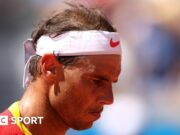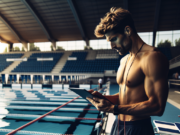Organizers of the Olympics have cited the climate crisis as the reason for the postponement of Tuesday’s men’s triathlon.
Paris 2024 reported that the amount of rain equivalent to the city’s average for July fell on Friday and Saturday, resulting in elevated levels of fecal bacteria known as E. coli contaminating the Seine and necessitating a delay for safety.
Following an inspection at 2:30 am, the men’s triathlon has been rescheduled for 9:45 am local time on Wednesday, while the women’s race is set to commence at 7 am.
After the announcement, organizers faced a multitude of inquiries regarding whether their desire to create visually striking broadcasts had placed the aesthetics of Paris above the safety of the athletes.
“We are in the 21st century, where unfortunately, there are more extreme weather events that occur, which are beyond the organizers’ control,” said Aurelie Merle, the sports director for Paris 2024.
“We went from heavy rainfall to extreme heat within just a few days. It’s genuinely challenging to manage how these fluctuations affect river quality.”
Merle disclosed that out of four testing locations on the Seine, only one was under the safe limit for E. coli on Tuesday. Two sites were slightly above the threshold while one was significantly higher, with readings ranging from 980 to 1,553. According to European standards, the acceptable limit is 900 colony-forming units per 100 milliliters.
“While there have been notable improvements, let’s be clear: we cannot control the weather,” Merle emphasized.
“The weather has significantly influenced the readings we are seeing today. However, it’s also evident that we had several days of extreme conditions leading up to this.”
Team GB’s Alex Yee and Beth Potter, who are the favorites for the men’s and women’s events respectively, now anxiously await to see if the water quality will improve enough for them to compete.
The expectation is for a full Olympic triathlon – comprising a 1500m swim, a 40km bike ride, and a 10km run – to happen on Wednesday, commencing under the Pont Alexandre III bridge and passing by several famous Paris landmarks.
Should there be further delays, a backup day is planned for Friday. However, if the Seine remains unsafe for swimming, the event will switch to a duathlon, replacing the 1500m swim with a 5km run.
Moreover, forecasts predict thunder and lightning within the next 24 hours, and higher than anticipated currents in the Seine pose additional concerns.
A source from Team GB mentioned that if the triathlon is postponed again on Wednesday, and considering the rain forecast, it will likely become a duathlon due to unfavorable water conditions. “The predictions indicate it will only worsen. For the athletes, it’s not merely about water quality; many have faced worse conditions during their careers. It’s about the strength of the currents if the waters are high.”
after newsletter promotion
“It will be exceptionally challenging if competitors have to swim against the current, significantly slowing their times. This is quite a demanding situation for those who may not be strong swimmers.”
The Pont Alexandre III in central Paris, captured on Tuesday. Photograph: Ed Alcock/The Guardian
Kit McConnell, the sports director of the International Olympic Committee, stated they are exploring options to ensure that friends and family of the competitors in the men’s event can still watch them race. “This is currently under discussion to find ways to accommodate it, combining two sessions into one tomorrow,” he mentioned.
Efforts to make the river swim-friendly have incurred costs of €1.4bn (£1.2bn), which include the construction of a large basin to capture excess rainwater and prevent wastewater from entering the river, the renovation of sewer infrastructure, and upgrades to treatment facilities.
Gergely Markus from World Triathlon confirmed that additional heat protection measures would be implemented on Wednesday if the races proceed, with temperatures expected to surpass 30C.
“We are already collaborating with the teams to enhance heat countermeasures,” he stated. “This includes providing more ice, additional water stations, and support for the athletes’ safety.”



































